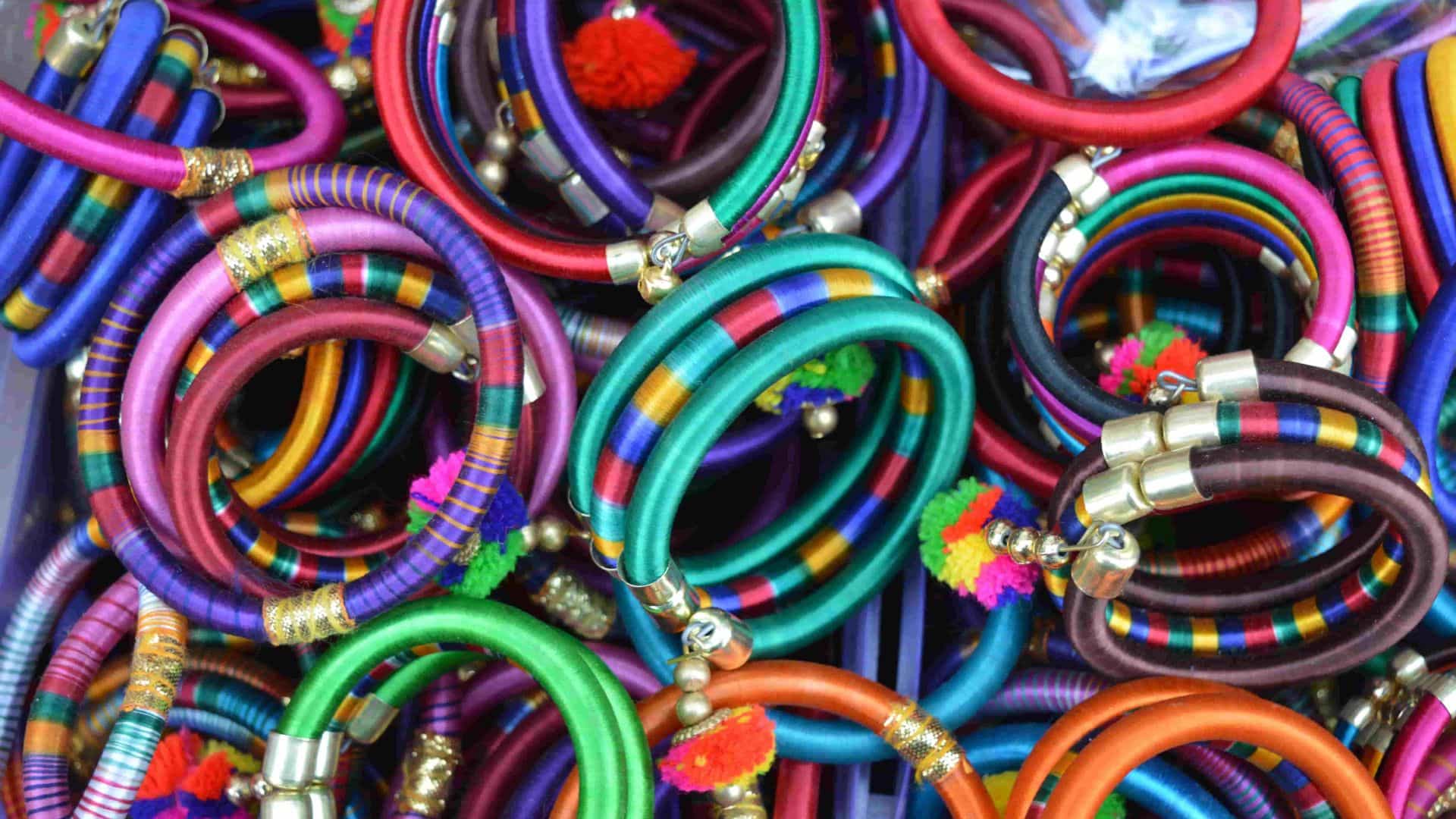What is an interesting fact about bangles?
One interesting fact about bangles is that they have been worn by women in South Asia and other parts of the world for thousands of years. In some cultures, bangles are considered a symbol of good fortune, prosperity, and marital status. They are often worn in large numbers and can be made from a variety of materials such as gold, silver, glass, plastic, or even wood. In some traditions, bangles are believed to have therapeutic properties and are worn to treat certain health conditions. Additionally, bangles are often given as gifts during important life events such as weddings or religious ceremonies.
How did the bangles get their name?
The word “bangle” is derived from the Hindi word “bangri” or “bungri,” which means “glass” or “bracelet.” The term was first used in English in the 18th century to describe a type of bracelet that was made of glass or other decorative materials and worn by women in India. Over time, the term “bangle” came to be used more broadly to refer to any type of circular bracelet that is worn around the wrist. Today, bangles are popular accessories worn by women in many cultures around the world and come in a wide variety of materials, designs, and styles.
What is the concept of a bangle?
A bangle is a type of bracelet that is circular in shape and is worn around the wrist. Bangles come in different styles, sizes, and materials and are worn by women in many cultures around the world. In some cultures, such as in South Asia, bangles are considered an important part of women’s jewelry and are worn in large numbers as a symbol of good fortune, prosperity, and marital status. Bangles can be made from a variety of materials such as gold, silver, glass, plastic, wood, or even ceramic. They are often worn for special occasions such as weddings or religious festivals, and some people believe that they have therapeutic properties and can be worn for health benefits. The concept of bangles varies across different cultures, but they are generally seen as a decorative accessory that enhances the beauty of the wearer.
What were the bangles known for?
Bangles have been known as an important accessory for women’s jewelry and fashion for thousands of years. They are traditionally worn in many cultures as a symbol of good fortune, prosperity, and marital status. Bangles are often worn in large numbers, creating a jingling sound as they move, and are considered an essential part of traditional dress in many parts of the world.
In some cultures, bangles are also believed to have therapeutic properties and are worn for their health benefits. For example, in Ayurvedic medicine, a traditional system of medicine in India, bangles made of specific metals or materials are believed to help balance the body’s energy and improve overall health.
Bangles are also known for their decorative and ornamental value. They come in a wide range of designs, styles, and materials, from simple and plain to highly decorative and intricately detailed. Many bangles are adorned with gems, beads, and other embellishments to add to their beauty.
Overall, bangles have been known throughout history for their cultural, social, and aesthetic significance, making them an important part of women’s fashion and jewelry.
What is a fun fact about bracelets?
One fun fact about bracelets is that they have been worn by both men and women for thousands of years, in various forms and styles. In ancient times, bracelets were worn as a symbol of power, status, and wealth. For example, in ancient Egypt, pharaohs and other high-ranking officials would wear bracelets made of precious metals and adorned with gemstones as a symbol of their authority.
Another interesting fact about bracelets is that they have been used for many purposes beyond just fashion. In some cultures, bracelets have been used as a form of currency or as a means of exchange. For example, in West Africa, bracelets made of gold or brass were used as a form of currency and were often worn by women as a way to store their wealth.
In modern times, bracelets continue to be popular fashion accessories and are worn by people of all ages and genders. They come in a wide range of styles, from simple and understated to bold and colorful, and can be made from a variety of materials, including metals, beads, leather, and fabric.
What does a bangle symbolize?
The meaning and symbolism of bangles can vary depending on the culture and tradition in which they are worn. Here are a few examples of what bangles may symbolize:
- In many South Asian cultures, bangles are worn as a symbol of good fortune, prosperity, and marital status. They are often worn in large numbers, with some brides wearing dozens of bangles on each arm, as a sign of their beauty, wealth, and desirability.
- In some African cultures, bracelets or bangles made of gold or brass are worn as a form of currency and a means of exchange. They may also be worn as a symbol of wealth, power, and social status.
- In some cultures, bangles are believed to have therapeutic properties and may be worn for their health benefits. For example, in Ayurvedic medicine, bangles made of specific metals or materials are believed to help balance the body’s energy and improve overall health.
- Overall, bangles are often seen as a decorative accessory that enhances the beauty of the wearer. They can be worn for special occasions such as weddings or religious festivals, or as a daily accessory to add to an outfit.
Types of bangles names
There are many types of bangles available, each with its own unique style, design, and materials used. Here are some of the most common types of bangles:
- Traditional Bangles: These are typically worn in South Asian cultures and come in sets of multiple bangles that are worn together. They can be made of metal, glass, or plastic and come in various colors.
- Cuff Bangles: These are wide bangles that cover a large portion of the wrist and can be made of metal, leather, or fabric. They often feature intricate designs and embellishments.
- Charm Bangles: These are bangles that have small charms or pendants hanging from them. They can be made of metal, leather, or fabric and are often worn as statement pieces.
- Tennis Bangles: These are thin, delicate bangles that are often set with diamonds or other precious stones. They are named after the popular tennis bracelet style and are typically worn for formal occasions.
- Slave Bangles: These are bangles that are designed to be worn on the upper arm rather than the wrist. They can be made of metal or fabric and are often decorated with beads, gems, or other embellishments.
- Banglet: These are small, delicate bangles that are often worn in multiples. They can be made of metal, plastic, or glass and are typically worn as everyday accessories.
- Thread Bangles: These are bangles made of thread or string and are often wrapped around the wrist multiple times. They can be adorned with beads or charms and come in various colors.
These are just a few examples of the many types of bangles available, and there are many other variations and styles as well.
Who invented bangles
It is difficult to pinpoint exactly who invented bangles, as they have been worn by various cultures throughout history. Bangles have been found in archaeological excavations dating back to ancient civilizations such as the Indus Valley, Mesopotamia, and Egypt.
In South Asian cultures, bangles have been worn for thousands of years as a traditional accessory, and their use has been documented in ancient texts and artwork. In these cultures, bangles are often seen as a symbol of good fortune, prosperity, and marital status.
Similarly, in African cultures, bracelets and bangles have been worn for centuries as a form of currency, a means of exchange, and a symbol of wealth and power.
Overall, bangles have been an important part of human adornment for thousands of years, and their history and evolution can be traced back through the cultural and artistic traditions of various civilizations.
Who died from the bangles?
There is no known record of anyone dying specifically from wearing bangles. However, it is important to note that any jewelry worn too tightly or for extended periods of time can potentially cause injury or harm. In some cases, wearing bangles or other jewelry may lead to skin irritation, allergic reactions, or other health issues, especially if the materials used in the jewelry are of poor quality or contain harmful substances.
It is always important to be cautious when wearing any type of jewelry and to make sure that it fits comfortably and is made of safe and high-quality materials. If you experience any discomfort or health issues while wearing bangles or other jewelry, it is best to remove them and seek medical attention if necessary.

